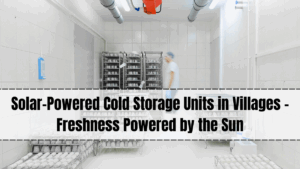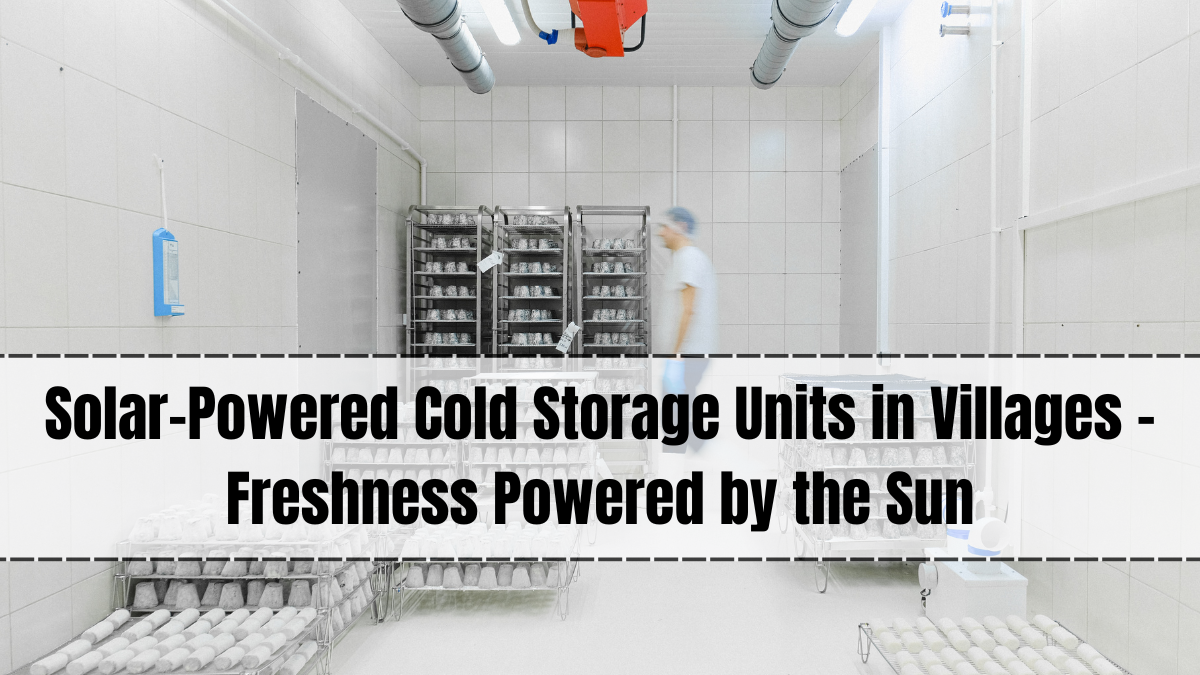In 2025, rural communities across India are embracing a powerful solution to one of their longest-standing problems: post-harvest food wastage. Every year, farmers lose a significant portion of their produce due to a lack of proper storage facilities. Perishable crops like fruits, vegetables, dairy products, and fish spoil quickly without cold storage, especially in hot and humid climates. For decades, the absence of reliable electricity in many villages made it nearly impossible to maintain cold storage units, forcing farmers to sell their produce immediately after harvest, often at low prices dictated by market demand.
The arrival of solar-powered cold storage units is changing this reality. These systems harness renewable energy from the sun to keep produce fresh for days or even weeks, giving farmers more control over when and where they sell their goods. By breaking the cycle of forced distress sales, solar-powered cold storage units are boosting farmer incomes, reducing waste, and supporting the overall rural economy.
This innovation is particularly important in India, where agriculture employs over half the workforce but suffers from inadequate supply chain infrastructure. Traditional cold storage facilities are often located far from farms, require expensive grid electricity, and are too costly for smallholder farmers to use regularly. Solar-powered units are decentralizing storage by bringing it directly to the village level, making it accessible, affordable, and environmentally friendly.

Why Villages Need Solar-Powered Cold Storage
The challenges faced by farmers without access to cold storage are well known:
-
High post-harvest losses due to spoilage, especially in perishable crops
-
Forced sales at low prices to avoid spoilage
-
Limited bargaining power in the market
-
Dependence on middlemen for quick sales and transport
-
Wasted resources such as water, fertilizers, and labor used in growing crops that are eventually lost
By enabling farmers to store produce for longer, solar-powered cold storage units give them flexibility in selling, allowing them to wait for favorable market conditions. This can make the difference between selling at a loss and earning a profit.
How Solar-Powered Cold Storage Works
These systems use solar photovoltaic panels to generate electricity, which powers refrigeration units. Some designs incorporate battery storage to ensure uninterrupted cooling during cloudy days or at night. Others combine solar power with thermal energy storage, where ice or cold water is used to maintain low temperatures without constant electricity.
Cold storage capacity varies from small units that hold 200–500 kg of produce to larger facilities that can store several tonnes. Farmers or cooperatives can rent space in these units for a small fee, making them affordable even for those with small harvests.
Many modern solar cold storage systems are also IoT-enabled, allowing operators to monitor temperature, humidity, and energy usage remotely. This ensures consistent quality control and prevents spoilage due to human error.
Benefits for Farmers
The introduction of solar-powered cold storage brings multiple advantages:
-
Reduced spoilage: Farmers can store crops like tomatoes, onions, milk, and fish for much longer.
-
Better prices: Instead of selling immediately after harvest when supply is high and prices are low, farmers can wait for market demand to rise.
-
Improved quality: Fresh, well-preserved produce commands higher prices in urban and export markets.
-
Lower operational costs: Solar energy reduces or eliminates electricity bills, making storage more affordable.
-
Environmental sustainability: These units rely on clean, renewable energy, reducing carbon emissions compared to diesel-powered alternatives.
Boosting the Rural Economy
Solar-powered cold storage units benefit more than just individual farmers. By reducing wastage, they ensure a more consistent food supply for local markets, help stabilize prices, and create job opportunities for unit operators, maintenance workers, and transport providers. Cooperatives and self-help groups can manage these units as community-owned enterprises, reinvesting profits into other village development projects.
With longer storage capacity, farmers can also diversify into higher-value crops such as berries, flowers, and specialty vegetables, which previously were too risky to grow due to their short shelf life. This diversification can increase rural incomes and open new markets.
Government and Private Sector Initiatives
In 2025, multiple government schemes are supporting the installation of solar-powered cold storage in rural areas. Subsidies under renewable energy programs, agricultural infrastructure funds, and climate resilience projects are making these systems more affordable. Private companies and startups are also playing a major role by offering modular, mobile, and pay-per-use cold storage solutions.
For example, some agri-tech startups are deploying solar cold rooms in partnership with farmer-producer organizations (FPOs), charging farmers only for the space and time used. This model reduces the financial burden of ownership while ensuring widespread access.
Success Stories from the Field
In Maharashtra, a cluster of vegetable farmers used a community-owned solar cold storage facility to store surplus produce during peak harvest season. By selling gradually over two weeks instead of in one day, they increased their earnings by nearly 30%. In Andhra Pradesh, fisherfolk are using solar-powered ice makers to preserve their catch, enabling them to transport it to distant urban markets without quality loss. In the Northeast, floriculture farmers are using solar cold rooms to keep flowers fresh for wedding and festival markets, significantly boosting sales.
Challenges and the Path Forward
While the benefits are clear, there are challenges to scaling solar-powered cold storage in every village. Upfront installation costs, though subsidized, can still be high for individual farmers. Awareness and training are crucial so that farmers know how to use the facilities effectively. Maintenance is another key issue—cold storage units require periodic servicing to ensure consistent performance, and local technicians must be trained to handle repairs.
The future lies in expanding access through cooperative ownership models, improving battery and thermal storage technologies, and integrating these units with digital platforms for market intelligence. With continued investment and community engagement, solar-powered cold storage can become a cornerstone of rural infrastructure, ensuring that farmers’ hard work translates into stable incomes and sustainable growth.
FAQs
What is a solar-powered cold storage unit?
It is a refrigeration facility powered by solar energy, used to store perishable agricultural products and extend their shelf life.
How does it help farmers?
It reduces post-harvest losses, allows farmers to sell at better prices, and preserves product quality.
Can small farmers afford it?
Yes, many units operate on a pay-per-use or cooperative model, making them affordable for smallholders.
Does it work at night or on cloudy days?
Yes, with battery storage or thermal energy storage, the system can function without direct sunlight.
Is it environmentally friendly?
Yes, it runs on renewable energy, reducing reliance on fossil fuels and lowering carbon emissions.
Click here to know more.
